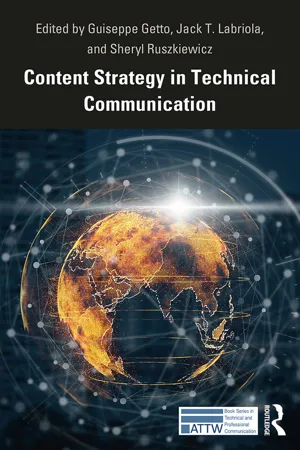
Content Strategy in Technical Communication
- 222 pages
- English
- ePUB (mobile friendly)
- Available on iOS & Android
Content Strategy in Technical Communication
About This Book
Content Strategy in Technical Communication provides a balanced, comprehensive overview of the current state of content strategy within the field of technical communication while showcasing groundbreaking work in the field.
Emerging technologies such as content management systems, social media platforms, open source information architectures, and application programming interfaces provide new opportunities for the creation, publication, and delivery of content. Technical communicators are now sometimes responsible for such diverse roles as content management, content auditing, and search engine optimization. At the same time, we are seeing remarkable growth in jobs devoted to these other content-centric skills. This book provides a roadmap including best practices, pedagogies for teaching, and implications for research in these areas. It covers elements of content strategy as diverse as "Editing Content for Global Reuse" and "Teaching Content Strategy to Graduate Students with Real Clients, " while giving equal weight to professional best practices and to pedagogy for content strategy.
This book is an essential resource for professionals, students, and scholars throughout the field of technical communication.
Frequently asked questions
Information
1
An Introduction to Content Strategy
- Technical communication practitioners working in industry who are being called upon to do content strategy work in some way, shape, or form.
- Technical communication practitioners seeking to inject content strategy best practices into their organizations through training or teaching.
- Technical communication researchers and students who are interested in learning about content strategy.
- Technical communication researchers who are willing to help contribute additional research into best practices within this growing discipline.
- Technical communication teachers looking to add content strategy into their pedagogies within academic or workplace contexts.
Defining Content Strategy
Introducing This Book
- Empirical research on content strategy best practices, which helps to cement them as the “best” things people are doing in industry (Albers, Flanagan, and Hovde, this volume).
- Explorations of emerging best practices, particularly doing content strategy in a variety of cultures, using augmented reality, and using dynamic content (Duin, Armfield, and Pedersen, and Albers, this volume).
- Case studies of teaching content strategy (Howard, Borgman, Steiner, and Behling and Bookman, this volume).
- Content strategy as information design (Albers & Mazur, 2003; Albers, 2012).
- Content strategy as a rhetorical approach to managing content within content management systems and other technologies (Pullman & Gu, 2008; Hart-Davidson, Bernhardt, McLeod, Rife, & Grabill, 2008).
- Curating and facilitating user-generated content (Getto & Labriola, 2016; Walwema, Sarat-St. Peter, & Chong, forthcoming).
- Component-based content strategy (Andersen & Batova, 2015; Batova & Andersen, 2015).
- Website-based content strategy (Batova & Andersen, 2016).
- Developing localized, multicultural content within content management systems (Batova, 2018).
- What uses does content foster in an era when communication technologies are increasingly pervasive, multiplicitous, and global in scope?
- How must usability and usefulness be redefined, and content reshaped, in light of the diversity of users and user experiences?
- How must we rethink the concept of the user when communication technologies share content with one another as much as they share it with people?
Content Strategy Best Practices
- Strategies for developing and deploying content (Albers, Flanagan, Howard, Borgman, and Getto, this volume).
- Use of emerging technologies and systems for managing and publishing content (Duin, Armfield, and Pedersen, Albers, and Flanagan, this volume).
- Usability and audience awareness (Hovde, Steiner, and Behling and Bookman, this volume).
Strategies for Developing and Deploying Content
- As part of an effort to audit existing content to ascertain how effective it is in respect to specific goals and metrics important to the organization.
- As part of an overall content strategy plan deployed as an authoritative document to govern all aspects of an organization’s content.
- As part of building an authoritative content repository for reuse and deployment across channels, often hosted in a content management system.
- As part of open source, structured authoring architectures like DITA or GitHub.
- As settings within structured authoring tools, deployed as software that individuals and groups of writers use to develop and manage content.
- As part of consumer-facing websites, many of which are built in popular content management systems like WordPress, Drupal, and Joomla!.
- As part of custom websites, mobile applications, and enterprise applications built for specific organizations, industries, or markets.
Use of Emerging Technologies and Systems for Managing and Publishing Content
- Content management systems (CMSs)
- Social media platforms
- Social media publishing tools such as HootSuite and Buffer
- Analytics tools such as Google Analytics
- Open source information architectures (i.e., DITA)
- User-generated platforms such as wikis and forums
- Website-building CMSs such as WordPress, Drupal, and Joomla!
- Proprietary content management, documentation, and word processing software such as Adobe Experience Manager, Adobe RoboHelp, Oxygen XML Editor, MadCap Flare, Doc-to-Help, and the Microsoft Office suite
- Customized versions of tools created for enterprise-level organizations with complex needs
Usability and Audience Awareness
Table of contents
- Cover
- Half Title
- Series Title
- Title
- Copyright
- Dedication
- Contents
- Series Editor Foreword
- Notes on Contributors
- 1 An Introduction to Content Strategy: Best Practices, Pedagogies, and What the Future Holds
- SECTION I Content Strategy Best Practices
- SECTION II Content Strategy Pedagogies
- Index